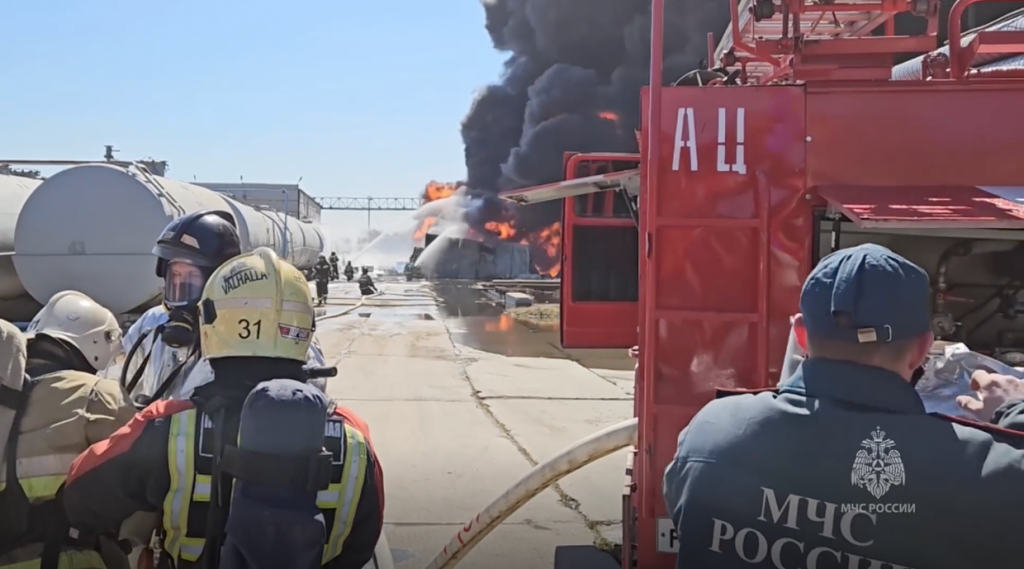A fire broke out at an oil production facility in the Siberian city of Omsk on April 25, with three 200-liter containers of petroleum products on fire. The cause of the fire was not immediately clear, and emergency workers were on the scene to assess the situation. While there was no direct evidence linking Ukraine to the fire at the time, it followed a series of drone strikes reportedly carried out by Ukrainian forces targeting Russia’s oil industry. These attacks included strikes on an oil refinery in Voronezh Oblast and an industrial zone in Lipetsk Oblast, as well as fires at facilities in Bryansk, Kaluga, and Smolensk oblasts on April 20. The impact of these attacks on Russia’s oil infrastructure raised concerns about potential repercussions on the global energy market.
U.S. Defense Secretary Lloyd Austin warned that Ukrainian attacks on Russian oil refineries could have a significant impact on the global energy situation. The escalation of hostilities between Ukraine and Russia, particularly targeting critical infrastructure such as oil facilities, raised concerns about the stability of the energy market. The attacks on Russian oil installations highlighted the vulnerability of such facilities to targeted strikes and the potential ripple effects on global energy supply and prices. Austin’s comments underscored the interconnected nature of the energy market and the potential consequences of conflicts in key producing regions.
The fire in Omsk, along with the previous drone strikes on Russian oil facilities, represented a broader pattern of attacks by Ukrainian forces on Russia’s energy infrastructure. The strategic targeting of oil refineries and industrial zones revealed a deliberate effort to disrupt Russia’s oil production and distribution networks. These attacks were part of Ukraine’s response to the ongoing conflict with Russia, aiming to weaken the opponent’s economic and military capabilities. The series of strikes on oil facilities underscored the role of energy resources in geopolitical conflicts and the use of such assets as leverage in warfare.
The location of Omsk in central Siberia, far from the Ukrainian border, raised questions about the potential motivations behind the fire at the oil production facility. While there was no direct evidence linking Ukraine to the incident, the proximity of previous drone strikes on Russian oil installations suggested a pattern of attacks on critical energy infrastructure. The ongoing hostilities between Ukraine and Russia, both major players in the global energy market, heightened concerns about the implications of such actions on energy security and stability. The fire at the Omsk facility underscored the vulnerability of oil infrastructure to external threats and highlighted the need for enhanced security measures in key production areas.
The attacks on Russian oil facilities, including the fire in Omsk, prompted discussions on the broader implications for the global energy market and potential disruptions to supply chains. The interconnected nature of the energy sector, with key producers and consumers linked by complex networks, meant that any disruption in one region could have far-reaching consequences. The targeting of oil refineries and industrial zones in Russia by Ukrainian forces highlighted the fragility of critical infrastructure in times of conflict and the challenges of protecting vital assets from attacks. The fire at the Omsk facility served as a reminder of the risks involved in oil production and the importance of safeguarding key facilities against potential threats.
In conclusion, the fire at the oil production facility in Omsk, along with the drone strikes on Russian oil installations, underscored the strategic targeting of energy infrastructure in the ongoing conflict between Ukraine and Russia. The attacks raised concerns about the potential impact on the global energy market and highlighted the vulnerability of critical facilities to disruptions. The broader implications of these actions on energy security and stability emphasized the need for enhanced security measures and contingency plans to mitigate risks in key producing regions. The incidents served as a reminder of the complex interplay between geopolitical conflicts and energy resources, underscoring the importance of safeguarding critical infrastructure in times of heightened tensions.


